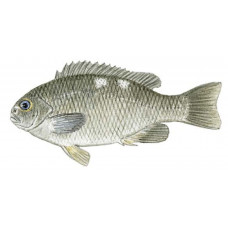Latin name
Girella nigricans
Other names
Green perch, black perch, blue-eyed perch, bluefish, Jack Benny, button-back; Japanese: mejina; Spanish: chopa verde.
Identification
The body is oval and compressed, the snout is thick and has a uniformly rounded profile, and the mouth is small. The coloration is dark olive green, and most individuals have one or two white spots on each side of the back below the middle of the dorsal fin. Its bright blue eyes and heavy body distinguish it from related species.
Distribution
Occurs from San Francisco, California, to Cabo San Lucas, Baja California.
Habitat
This species inhabits rocky shores and kelp forests. Adult aggregations are found off the coast of California in water depths of 65 feet and deeper.
Size
Their maximum length reaches 251⁄2 inches and their weight is 131⁄2 pounds.
Life history and Behavior
During spawning, which occurs from April through June, fish form dense schools in shallow waters. Eggs and larvae swim freely and can be found many miles from shore. Juveniles form schools of up to two dozen individuals. At about 1 inch long, they enter tidal pools, gradually deepening as they grow.
Food and feeding habits
They feed mainly on seaweeds, both with and without organisms inclusions. Other food sources include kelp, giant kelp, sea lettuce, coralline algae, small tube-living worms and red crabs.
Reproduction
They mature and spawn when they reach 8-9 inches in length and are 2-3 years old.
| Classification | |
| Phylum | Chordata |
| Class | Actinopterygii |
| Squad | Perciformes |
| Family | Kyphosidae |
| Genus | Strongylura |
| Species | Carangiformes |
| Features | |
| Conservation status | Least Concern |
| Habitat | Littoral |
| Life span, years | No information |
| Maximum body weight, kg | No information |
| Maximum length, cm | 66 |
| Sailing speed, m/s | No information |
| Threat to people | Edible |
| Way of eating | Planktonophage |
Opaleye
Tags: Opaleye



